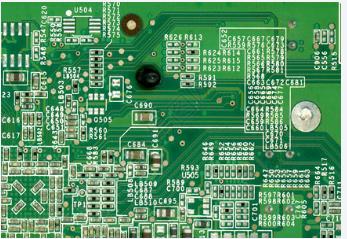PCB board used in actual electronic products vary greatly, and they are classified according to different standards.
1. Classification by distribution of printed circuits
According to the distribution of printed circuits, printed circuit boards can be divided into single panel, double-sided board and multi-layer plate.
• single panel
The single panel is on an insulating substrate with a thickness of 0.2-5mm, only one surface is coated with copper foil, and the printed circuit is formed on the substrate by printing and corrosion. The single panel has the advantages of simple manufacture and convenient assembly, and is suitable for the requirements of one discharge circuit, such as radio, television, etc; It is not suitable for occasions requiring high assembly density or complex circuits.
• double sided board
The double panel is printed on both sides of an insulating substrate with a thickness of 0.2-5mm. It is applicable to electronic products with general requirements, such as electronic computers, electronic instruments and meters. Because the wiring density of double-sided board printed circuit is higher than that of single panel, the volume of equipment can be reduced.
• multi ply panels
A printed board that prints more than three layers of printed circuits on an insulating substrate is called a multilayer board. It is composed of several thin single panels or double-sided panels, and its thickness is generally 1.2-2.5mm. In order to lead out the circuit clamped in the middle of the insulating substrate, the hole for installing components on the multilayer board needs to be metallized, that is, an effective metal layer is coated on the inner surface of the hole to connect it with the printed circuit clamped in the middle of the insulating substrate.
The following figure is the structural diagram of multilayer board. Most of the components used in multilayer board are patch components, which are characterized by:
1. Combined with integrated circuit, the whole machine can be miniaturized and the weight of the whole machine can be reduced;
2. The wiring density is improved, the spacing of components is reduced, and the signal transmission path is shortened;
3. The welding points of components are reduced and the failure rate is reduced;
4. A shielding layer is added to reduce the signal distortion of the circuit;
5. The introduction of grounding heat dissipation layer can reduce local overheating and improve the reliability of the whole machine;

2.Classification according to the properties of substrate
Printed circuit boards can be divided into rigid and flexible according to the properties of the substrate.
Rigid printed board
The rigid printed board has a certain mechanical strength, and the components assembled with it have a flat state. Rigid printed boards are used in general electronic products.
flexible printed board
Flexible printed board is made of soft layered plastic or other soft insulating materials. The parts made of it can be bent and retracted, and can be bent according to the installation requirements when in use. Flexible printed boards are generally used in special occasions. For example, the display screen of some digital multimeter can rotate, and flexible printed boards are often used inside; Display screen, keys, etc. of mobile phone.
The figure below shows the flexible printed board of mobile phone. Its base material is polyimide, and the surface is anti-oxidation treated. The minimum line width and line distance are set to 0.1mm. The outstanding feature of flexible printed board is that it can bend, curl and fold, and connect rigid printed board and movable parts, so as to realize three-dimensional wiring and three-dimensional space interconnection. It has the advantages of small volume, light weight and convenient assembly. It is suitable for electronic products with small space and high assembly density.
3. Classification by scope of application
According to the scope of application, printed circuit boards can be divided into low-frequency and high-frequency printed circuit boards.
High frequency of electronic equipment is the development trend, especially in today's wireless network and satellite communication, information products are moving towards high-speed and high-frequency, and communication products are moving towards the standardization of voice, video and data with large capacity and high-speed wireless transmission. Therefore, the new generation of products need high-frequency printed boards. The foil substrate can be composed of materials with low dielectric loss and dielectric constant, such as polytetrane ethylene, haoethylene, polystyrene, polytetrafluoroethylene glass cloth and so on.
4. Types of special printed boards
At present, there are also some special printed boards, such as metal core printed boards, surface mounted printed boards, carbon film printed boards and so on.
Metal core PCB printed board
Metal core printed board is to replace epoxy glass cloth board with a metal board with equivalent thickness. After special treatment, the conductor circuits on both sides of the gold board are connected with each other and highly insulated from the metal part. The advantage of metal core printed board is good heat dissipation and dimensional stability. This is because magnetic materials such as aluminum and iron have shielding effect, which can prevent mutual interference.
Surface mount printed board
Surface mount printed board is a printed board developed to meet the needs of "light, thin, short and small" electronic products and cooperate with the installation process of surface mount devices with pin density and low cost. The printed board has the characteristics of small aperture, small linewidth and spacing, high precision and high substrate requirements.
Carbon film printed board
Carbon film printed board is a printed board which is made of conductor pattern on copper-plated foil board and then printed with a layer of carbon film to form contact or jumper (resistance value meets the specified requirements). It is characterized by simple production process, low cost, short cycle, good wear resistance and conductivity. It can realize high density of single panel, miniaturization and lightweight of products. It is suitable for TV, telephone, video recorder, electronic organ and other products.